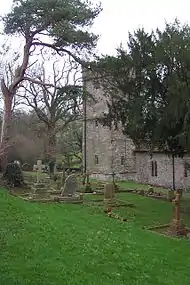St Jerome's Church, Llangwm
The Church of St Jerome stands in the settlement of Llangwm Uchaf, (upper) Llangwm, in a remote part of Monmouthshire, Wales. Originally constructed in the twelfth century, in an Early English style, it was heavily restored in the nineteenth century. The church has a "large and unusual"[1] tower, an "outstanding"[1] late-Medieval rood screen and Victorian interior fittings of "exceptional quality".[1] After being declared redundant by the Church in Wales, the church is now administered by the Friends of Friendless Churches. It was designated a Grade I listed building on 19 August 1955.
| Church of St Jerome, Llangwm Uchaf, Llangwm | |
|---|---|
 | |

| |
| 51.696°N 2.830°W | |
| Location | Llangwm, Monmouthshire |
| Country | Wales |
| History | |
| Status | Redundant |
| Dedication | St Jerome |
| Architecture | |
| Heritage designation | Grade I |
| Designated | 19 August 1955 |
| Architect(s) | John Pollard Seddon - Restoration |
History and architecture
The church is constructed of Old Red Sandstone and is first mentioned in 1128.[2] It is built in the Early English style. It has a tower, without buttresses, a large nave and chancel and a porch.[1] Largely ruined by the 19th century, it was comprehensively restored and partly rebuilt in 1863-9 by John Pollard Seddon.[3][2] Repairs were carried out by The Friends of Friendless Churches in 2013–4.[4][5]
Interior
The church contains a remarkable medieval rood screen and rood loft, c. 1500, restored during Seddon's 19th-century reconstruction.[3] It has been described as a breathtaking sight, rising almost to the roof [6] and one of the most spectacular rood screens in south Wales.[7] It has been suggested that the village's remoteness saved the screen from destruction by the Puritans.[8] Newman writes that "the glory of the interior is the rood screen and loft",[2] which British Listed Buildings Online describes as "one of the finest in Britain" and of "exceptional richness and complexity."[1] It has been heavily, but sympathetically, restored by Seddon. Of the same, latter, date, the lectern, the font, the choir stalls, the pews and the tiling throughout the church, the whole representative of Seddon "at his most imaginative."[2]
Behind the screen, carved in the chancel arch, can be seen three "green men with verdure sprouting from their mouths."[9] The sculptures are believed to have inspired Julia, Lady Raglan to write about the "Green Man" motif in her seminal 1939 article "The Green Man in Church Architecture" in The Folklore Journal.[10][3]
Buried in the chancel of the church, though no memorial to him survives, is Walter Cradock, the 17th-century cleric born at Trefela 1.5 miles (2.4 km) south of the church.[7] He was inspired to become an Independent by fellow church Dissenter William Wroth.
Swansea University historian Dr Alun Withey has examined in some detail a 1671 dispute over the church seating arrangements. He reports that the village was ablaze, with divers[e] variances, quarrels and debates even lawsuits, to the utter destruction and overthrow of manie. It was left to the churchwarden, respected local yeoman farmer John Gwin, to settle matters. Gwin's notebook containing his seating plan still survives, giving us, Withey argues, a rare insight into the world of parochial life in 17th-century Wales, and thus contributes greatly to our general understanding of Welsh history.[11]
The church is a Grade I listed building.[12] It has been declared redundant and is in the care of the Friends of Friendless Churches. It was repaired in 2013–2014.[5]
Notes
- Good Stuff IT Services (1963-08-19). "Church of St Jerome, Llangwm Uchaf". British Listed Buildings. Retrieved 2012-02-12.
- The Buildings of Wales:Gwent/Monmouthshire, page 316-7
- Jenkins, Simon (2008). Wales / Churches, Houses, Castles. London: Allen Lane / Penguin Group. p. 186. ISBN 978-0-713-99893-1.
- Good Stuff IT Services. "Llangwm Uchaf". Friends of Friendless Churches. Archived from the original on 2014-05-19. Retrieved 2012-02-12.
- "Llangwm Uchaf". Friends of Friendless Churches. Archived from the original on 19 May 2014. Retrieved 18 May 2014.
- John Newman, The Buildings of Wales: Gwent/Monmouthshire, 2000, ISBN 0-14-071053-1
- "Llangwm church at The Cistercian Way". cistercian-way.newport.ac.uk. Archived from the original on 28 May 2014. Retrieved 2 January 2017.
- sylvia@fowles.org.uk. "Llangwm and District Community Website". llangwm.org.uk. Retrieved 2 January 2017.
- Wales - Churches, Houses, Castles, page 187
- ": Theories and Interpretations". The Enigma of the Green Man. Retrieved 24 August 2016.
- Alun Withey (30 March 2012). "Welsh History Month: Llangwm Uchaf, in Monmouthshire". Media Wales Ltd. Retrieved 24 January 2013.
- Stuff, Good. "Church of St Jerome, Llangwm Uchaf - Llangwm - Monmouthshire - Wales - British Listed Buildings". britishlistedbuildings.co.uk. Retrieved 2 January 2017.
References
- Jenkins, Simon (2008). Wales - Churches, Houses, Castles. Allen Lane; London;
- Newman, John (2002). Gwent/Monmouthshire. New Haven; London: Yale University Press. ISBN 978-0-300-09630-9.